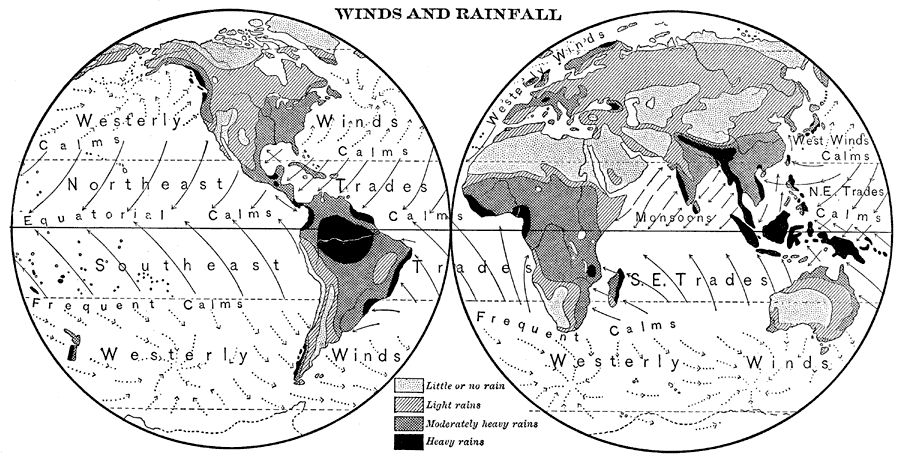Description: This is a map from 1898 of winds and rainfall over the Earth. "Like nearly all other substances, the air [in the atmosphere] expands and occupies more space when heated. If the atmosphere over any region becomes warmer then that over surrounding regions, it expands upward and becomes deeper over the hot region. The upper air therefore flows off side-wise from above the warmer region, while surface currents of cooler and heavier air flow in below and force the warmer and lighter air upward. Such surface currents of air are called winds." Trade Winds are the "gentle, steady winds" associated with the equator. "The northeast and southeast trade winds, when they meet, are forced slowly upward by the cooler and heavier air behind. The rising air expands and cools. The place of meeting of the trade winds is therefore marked by a narrow belt of light breezes or calms, in which there is almost constant cloudy and rainy weather. This belt is called the equatorial calms...At the outer edge of the trade winds, in both the northern and southern hemisphere, is a narrow belt or region in which the air is slowly settling down from the upper atmosphere, and becoming warmer as it descends. These belts are consequently marked by calms and clear weather. They are called the tropical calms...Prevailing Westerly Winds. Beyond the tropical calms the general movement of the atmosphere is toward the poles – from the southwest in the northern hemisphere, and from the northwest in the southern hemisphere...Cyclones. The winds of the temperate zones, however, are rendered very irregular by being drawn into vast whirls called cyclones, which are constantly forming and moving eastward in various parts of these zones...Monsoon Winds. Owing to the shifting of the heat equator, and of the belts of calms, with the change of seasons, much of the land in the torrid zone is north of the equatorial calms in January, and south of them in July. As the prevailing winds blow obliquely toward these clams, it follows that in many torrid lands the winds blow from one direction in summer and from another direction in winter. This seasonal change in the direction of the wind is strongly marked in southern Asia and eastern Africa, and on those coasts the prevailing winds are called monsoons, from a word meaning ‘season’...The winds are the great vapor carriers, and hence the rainfall of the world depends largely upon the winds. But the winds do not yield cloud and rain unless the vapor they carry is chilled. The vapor may be chilled (1) by rising higher in the atmosphere, or (2) by being carried into a colder region. The term rainfall usually includes snowfall also...Rainfall of the Torrid Zone...As the trade winds advance over the oceans they grow warmer and thirstier, and evaporate so much water that the sea is more salty in these regions than elsewhere...Over the Atlantic and Pacific oceans, this belt never moves far from the equator, and so much fresh water pours down as rain in that region that the sea there is less salty than in the trade-wind belts on either side...Rainfall of the Temperate Zones...These winds cool quite slowly. They start from the tropical calms as dry winds, and do not yield much rain until they are chilled either in cyclones or by rising over the highlands. Thus highlands and cyclones are the rain producers of the temperate zones." —Redway, 1898.
Place Names: A Complete Map of Globes and Multi-continent, Westerly Winds, �Calms, �N. E. Trades, �Southeast Trades, �S. E. Trades, �Monsoons, �Northeast Trades, �Frequent Calms, �Little or no rain, �light rains, �moderately heavy rains, �heavy rain
ISO Topic Categories: climatologyMeteorologyAtmosphere
Keywords: Winds and Rainfall, meteorological, �historical, kClimate, rainfall,
winds, climatologyMeteorologyAtmosphere, Unknown,1898
Source: Jacques W. Redway and Russell Hinman, Natural Advanced Geography (New York, NY: American Book Company , 1898) 26
Map Credit: Courtesy the private collection of Roy Winkelman |
|
